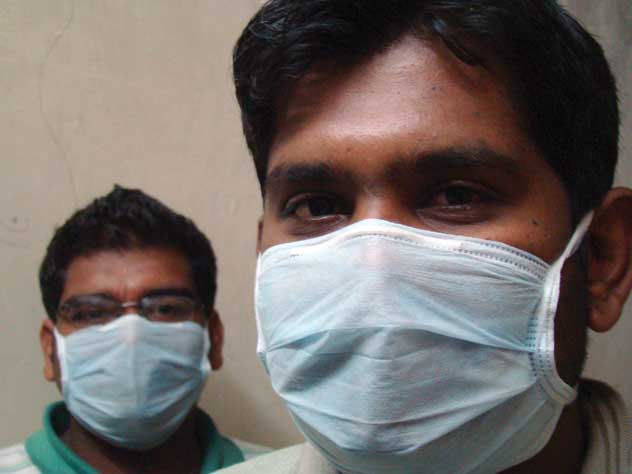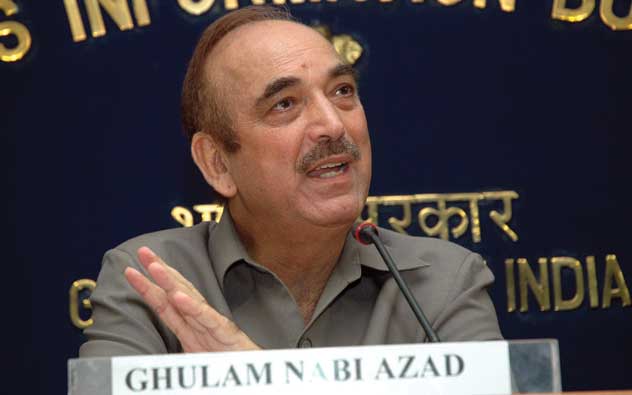SUBCONTINENT:
Unhealthy Mess: Swine Flu in India
The bigger scandal in the wake of India’s swine flu panic is India’s abysmal public health infrastructure, writes Siddharth Srivastava.

(Above): Two persons with protective masks in Pune, Maharashtra, the epicenter of India’s swine flu epidemic.
While India has been in a state of panic over the last few weeks due to swine flu, a larger health risk appears to have escaped the scrutiny of analysts and pundits alike —the fact that the looming pandemic has exposed the underbelly of India’s abysmal public health infrastructure and the urgent need for reform.
Fears have been exacerbated due to the bureaucratic response of the federal Health Ministry by limiting the treatment to government hospitals, death traps in themselves and infamous for flash strikes, unhygienic conditions, shabby, indifferent behavior of staff, unending queues, absentee doctors, overstretched amenities and often a surefire way to contract infectious bacterial diseases even if one is fine.
Anybody with some cash in his/her pocket or a medical insurance policy in India today keeps a safe distance from a government hospital.
Except in the case of swine flu there has been no choice, with the federal Health Minister Ghulam Nabi Azad fueling fears by declaring that in time a third of Indians could be infected with the flu.
“It is a scary situation to be in,” the mother of an infected child said. “Tests for swine flu are available only in government hospitals in conditions that are deplorable.”
There have been instances where crucial swab reports have been delayed due to intervening weekend holidays; a young girl in Pune died as her reports were released too late for medication to have any impact; many have been infected while waiting to be tested.
Driven by commercial concerns and rich foreign clients finicky about catching infections, private hospitals have also not helped matters by refusing to set aside isolation infrastructure needed to treat swine flu patients, given the Health Ministry’s belated moves to involve them.
This is not how hospitals are supposed to function.
Indeed, in the absence of systematic reforms India’s public health care systems are a nightmare with even government personnel themselves, tasked with running the free hospitals, taking the easy route of referrals to private hospitals for treatment that cost the exchequer huge sums of money.

(Above): The Union Minister for Health and Family Welfare Ghulam Nabi Azad briefing the media on H1N1 in New Delhi Aug. 10.
The deaths so far and thousands of swine flu infected, tragic as they may be, is statistically insignificant when compared to India’s ongoing medical tragedy, not usually reported by urban-based media, which are manned by people who belong to the classes that use medical insurance and private care: Thousands of India’s poor continue to perish due to easily preventable and curable infectious diseases such as TB, dysentery, malaria, typhoid, influenza and pneumonia.
The extension of even basic treatment can save innumerable lives.
Tuberculosis, for example, is the single largest killer communicable disease in India, impacting the poor the most. Over 2 million people die of TB worldwide each year, with about 400,000 deaths in India alone, afflicting the 15-45 age-group, given rampant smoking habits.
Diarrhea takes a toll on infants and young children. According to 2006 data, of the 1.8 million diarrhea deaths in the world, India lost 450,000.
India also reports the largest number of pneumonia deaths in the world.
Indeed, the failure of the government to extend basic health services and even education to a huge proportion of India’s population is shameful.
This has made private hospitals more mercenary in their approach, due to absence of a half decent choice and competition.
Yet, the emerging India story suggests that the future doesn’t have to be grim.
In telecommunications, for example, competition has driven down prices of cell phones and call rates that are affordable to many more than just the middle and upper classes, who can be in touch with near and dear ones, access important information and conduct small businesses.
India’s public sector banks such as State Bank of India with highest penetration rates have drastically improved services in the face of competition from private banks.
Setting up of public transport systems such as the cheap and comfortable metro rail, have benefited everybody.
There is, however, a long way to go in delivering education and health, essential services that should be available to all, in which the state needs to play a leading role.
Indeed, the outbreak of swine flu in India has once again underlined the socio-economic divisions in the Indian population — those who have benefited from India’s growth story (the affluent classes) and those who struggle (the masses) to eke out a bare existence, with the state failing to offer a decent middle ground.
The former thrive in air conditioned homes, cars, offices and if needed visit private hospitals that approximate five star hotels that also makes the country a top global medical outsourcing destination; the latter subsist in shanties without water or electricity and line up at the shabby, outdated and dirty government hospitals, if required.
There are times, however, when the two sections need to intermingle such as the outbreak of a new infection such as swine flu. Maybe a silver lining in the current dark cloud of the global pandemic could be a renewed awareness to overhaul the nation’s healthcare infrastructure into one that is more equitable and humane.
|